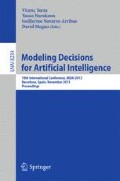Abstract
Most of recent anonymization algorithms for networks are based on edge modification, i.e., adding and/or deleting edges on a network. But, no one considers the edge’s relevance in order to decide which edges may be removed and which ones must be preserved. Considering edge’s relevance can help us to improve data utility and reduce information loss. In this paper we analyse different measures for quantifying edge’s relevance. Also, we present a new simple metric for edge’s relevance on medium or large networks.
Access this chapter
Tax calculation will be finalised at checkout
Purchases are for personal use only
Preview
Unable to display preview. Download preview PDF.
References
Backstrom, L., Dwork, C., Kleinberg, J.: Wherefore art thou r3579x?: anonymized social networks, hidden patterns, and structural steganography. In: Proceedings of the 16th International Conference on World Wide Web, pp. 181–190. ACM, New York (2007)
Sweeney, L.: k-anonymity: a model for protecting privacy. International Journal of Uncertainty, Fuzziness and Knowledge-Based Systems 10(5), 557–570 (2002)
Ying, X., Pan, K., Wu, X., Guo, L.: Comparisons of randomization and k-degree anonymization schemes for privacy preserving social network publishing. In: Proceedings of the 3rd Workshop on Social Network Mining and Analysis, pp. 10:1-10:10. ACM, New York (2009)
Girvan, M., Newman, M.E.J.: Community structure in social and biological networks. Proceedings of the National Academy of Sciences of the United States of America 99(12), 7821–7826 (2002)
Hay, M., Miklau, G., Jensen, D., Weis, P., Srivastava, S.: Anonymizing Social Networks. Technical Report, University of Massachusetts Amherst, pp. 1–17 (2007)
Ying, X., Wu, X.: Randomizing Social Networks: A Spectrum Preserving Approach. In: SIAM Conference on Data Mining (SDM), pp. 739–750. SIAM, Atlanta (2008)
Liu, K., Terzi, E.: Towards identity anonymization on graphs. In: Proceedings of the 2008 ACM SIGMOD International Conference on Management of Data, pp. 93–106. ACM, New York (2008)
Hay, M., Miklau, G., Jensen, D., Towsley, D., Weis, P.: Resisting structural re-identification in anonymized social networks. Proceedings of the VLDB Endowment 1(1), 102–114 (2008)
Chakrabarti, D., Faloutsos, C.: Graph mining: Laws, generators, and algorithms. ACM Computing Surveys (CSUR) 38(1), 2:1-2:69 (2006)
Zachary, W.W.: An information flow model for conflict and fission in small groups. Journal of Anthropological Research 33(4), 452–473 (1977)
Gleiser, P., Danon, L.: Community structure in jazz. Advances in Complex Systems 6(04), 565–573 (2003)
Duch, J., Arenas, A.: Community identification using Extremal Optimization. Physical review. E, Statistical, Nonlinear, and Soft Matter Physics 72(2), 027104 (2005)
Seary, A.J., Richards, W.D.: Spectral methods for analyzing and visualizing networks: an introduction. In: National Research Council, Dynamic Social Network Modelling and Analysis: Workshop Summary and Papers, pp. 209–228 (2003)
Zou, L., Chen, L., Özsu, M.T.: K-Automorphism: A General Framework For Privacy Preserving Network Publication. In: Proceedings of the Thirtieth International Conference on Very Large Data Bases (VLDB 2009), vol. 2(1), pp. 946–957 (2009)
Zhou, B., Pei, J.: Preserving privacy in social networks against neighborhood attacks. In: Proceedings of the 2008 IEEE 24th International Conference on Data Engineering, pp. 506–515. IEEE Computer Society, Washington, DC (2008)
Grady, D., Thiemann, C., Brockmann, D.: Robust classification of salient links in complex networks. Nature Communications 3, 864:1–864:10 (2012)
Author information
Authors and Affiliations
Editor information
Editors and Affiliations
Rights and permissions
Copyright information
© 2013 Springer-Verlag Berlin Heidelberg
About this paper
Cite this paper
Casas-Roma, J., Herrera-Joancomartí, J., Torra, V. (2013). Analyzing the Impact of Edge Modifications on Networks. In: Torra, V., Narukawa, Y., Navarro-Arribas, G., Megías, D. (eds) Modeling Decisions for Artificial Intelligence. MDAI 2013. Lecture Notes in Computer Science(), vol 8234. Springer, Berlin, Heidelberg. https://doi.org/10.1007/978-3-642-41550-0_26
Download citation
DOI: https://doi.org/10.1007/978-3-642-41550-0_26
Publisher Name: Springer, Berlin, Heidelberg
Print ISBN: 978-3-642-41549-4
Online ISBN: 978-3-642-41550-0
eBook Packages: Computer ScienceComputer Science (R0)

